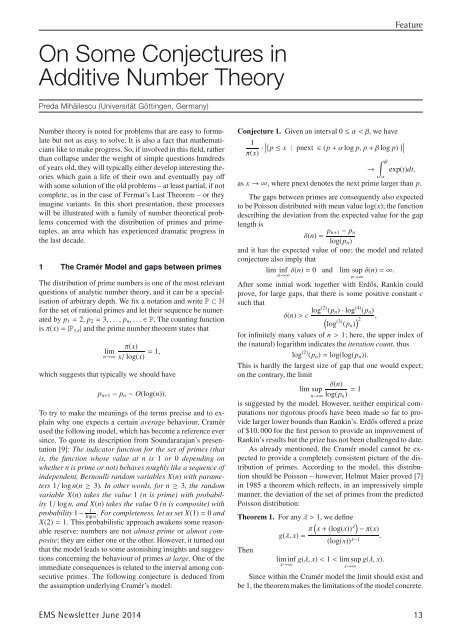1mZ2hsN
1mZ2hsN
1mZ2hsN
Create successful ePaper yourself
Turn your PDF publications into a flip-book with our unique Google optimized e-Paper software.
On Some some Conjectures inAdditive in Additive Number Number Theory TheoryPreda Mihăilescu (Universität Göttingen, Germany)FeatureNumber theory is noted for problems that are easy to formulatebut not as easy to solve. It is also a fact that mathematicianslike to make progress. So, if involved in this field, ratherthan collapse under the weight of simple questions hundredsof years old, they will typically either develop interesting theorieswhich gain a life of their own and eventually pay offwith some solution of the old problems – at least partial, if notcomplete, as in the case of Fermat’s Last Theorem – or theyimagine variants. In this short presentation, these processeswill be illustrated with a family of number theoretical problemsconcerned with the distribution of primes and primetuples,an area which has experienced dramatic progress inthe last decade.1 The Cramér Model and gaps between primesThe distribution of prime numbers is one of the most relevantquestions of analytic number theory, and it can be a specialisationof arbitrary depth. We fix a notation and write P ⊂ Nfor the set of rational primes and let their sequence be numeratedby p 1 = 2, p 2 = 3,...,p n ,...∈ P. The counting functionis π(x) = |P ≤x | and the prime number theorem states thatlimn→∞π(x)x/ log(x) = 1,which suggests that typically we should havep n+1 − p n ∼ O(log(n)).To try to make the meanings of the terms precise and to explainwhy one expects a certain average behaviour, Cramérused the following model, which has become a reference eversince. To quote its description from Soundararajan’s presentation[9]: The indicator function for the set of primes (thatis, the function whose value at n is 1 or 0 depending onwhether n is prime or not) behaves roughly like a sequence ofindependent, Bernoulli random variables X(n) with parameters1/ log n(n ≥ 3). In other words, for n ≥ 3, the randomvariable X(n) takes the value 1 (n is prime) with probability1/ log n, and X(n) takes the value 0 (n is composite) withprobability 1 − 1log n. For completeness, let us set X(1) = 0 andX(2) = 1. This probabilistic approach awakens some reasonablereserve: numbers are not almost prime or almost composite;they are either one or the other. However, it turned outthat the model leads to some astonishing insights and suggestionsconcerning the behaviour of primes at large. One of theimmediate consequences is related to the interval among consecutiveprimes. The following conjecture is deduced fromthe assumption underlying Cramér’s model:Conjecture 1. Given an interval 0 ≤ α c log(2) (p n ) · log (4) (p n )log (3) (p n ) ,2for infinitely many values of n > 1; here, the upper index ofthe (natural) logarithm indicates the iteration count, thuslog (2) (p n ) = log(log(p n )).This is hardly the largest size of gap that one would expect;on the contrary, the limitlim supn→∞δ(n)log(p n ) = 1is suggested by the model. However, neither empirical computationsnor rigorous proofs have been made so far to providelarger lower bounds than Rankin’s. Erdős offered a prizeof $10, 000 for the first person to provide an improvement ofRankin’s results but the prize has not been challenged to date.As already mentioned, the Cramér model cannot be expectedto provide a completely consistent picture of the distributionof primes. According to the model, this distributionshould be Poisson – however, Helmut Maier proved [7]in 1985 a theorem which reflects, in an impressively simplemanner, the deviation of the set of primes from the predictedPoisson distribution:Theorem 1. For any λ>1, we defineg(λ, x) = π x + (log(x)) λ − π(x).(log(x)) λ−1Thenlim inf g(λ, x) < 1 < lim sup g(λ, x).x→∞x→∞Since within the Cramér model the limit should exist andbe 1, the theorem makes the limitations of the model concrete.EMS Newsletter June 2014 13


